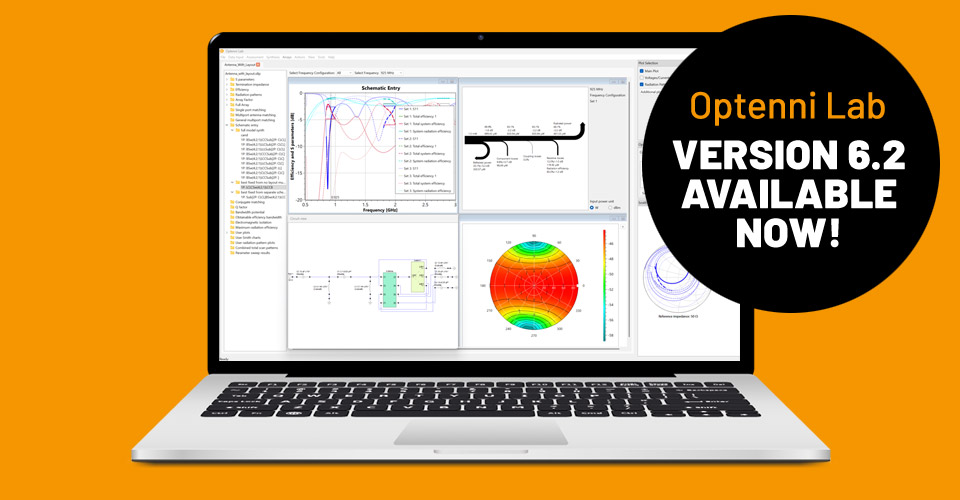
Explore – Accelerate – Maximize
Posted by Jussi Rahola | 20 September 2023
With this article I would like to welcome you to the new Optenni blog series. In this blog we will be discussing various matters related to RF circuit synthesis, impedance matching, antenna arrays and our Optenni Lab circuit synthesis software for antenna and RF optimization.
When re-designing the pages, we also re-thought the key messages about our software. The key benefits of Optenni Lab can be condensed in the three verbs: explore, accelerate and maximize.
Using these verbs, let me now explain in more detail what Optenni Lab can offer you.
You may also have noticed a new look and feel for our web pages at www.optenni.com.
Explore theoretical limits:
Optenni Lab has several innovative assessment tools which help to reveal the theoretical upper limits for the wireless performance of your antenna or RF system. If your system requirements are not met with the theoretical upper limits revealed by Optenni Lab, you should likely redesign your antenna radiator structure, and not spend time in vain trying to improve the matching.
The main assessment tools are as follows:
- Bandwidth potential: using the impedance of an unmatched antenna, the bandwidth potential calculation quickly reveals the obtainable bandwidth of the antenna through a matching circuit as a function of frequency. Thus, you can quickly determine if your antenna can provide the requested impedance bandwidth after it has been matched.
- Electromagnetic isolation: when working with antenna systems, you may initially think that there is a good isolation between two antenna ports. However, most of the isolation may come from impedance mismatch. The concept of electromagnetic isolation removes the effect of impedance mismatch from the calculation and determines the worst-case isolation for each frequency (when the two antennas are simultaneously matched). In converse, for linear amplifiers, the electromagnetic isolation calculation gives the best possible transducer power gain.
- Total scan pattern: when working with antenna arrays and beam steering, the beam can only be steered to a certain amount away from the broadside direction before the gain begins to drop and grating lobes start to appear. Optenni Lab implements the total scan pattern calculation, which reveals the maximum gain of the antenna array to any direction. Optenni Lab can also combine the total scan patterns from multiple arrays to determine if they together can provide a more uniform angular coverage of the beams.
Accelerate your design flow:
Accelerating the RF circuit design flow is at the heart of Optenni Lab. Instead of placing and wiring matching components manually, you can leverage the powerful circuit synthesis capabilities of Optenni Lab. After reading in your impedance and radiation data, just specify the desired operation bands and component types, and within seconds Optenni Lab can provide multiple optimized matching circuit topologies. Optenni Lab can optimize broadband and multiband matching circuits also for tightly coupled antenna systems.
The real power of Optenni Lab’s synthesis and optimization algorithms is revealed when tunable and switchable matching circuits are optimized. With Optenni Lab, frequency bands can be grouped into frequency configurations, where each configuration contains the frequency bands which need to be covered by a single switch or tuner state. At the same time, the input port of the system can have a common matching circuit that is to be identical to all states of the system. The optimization of such circuits is a complex task as the total performance depends on the circuit topology, component values and switch and tuner states.
A key part of the acceleration of the design flow is the capability of Optenni Lab to link with leading electromagnetic simulators and measurement equipment. Together with the EM tool vendors we have developed automated links so that simulated S parameters and radiation patterns can be sent from the EM tool to Optenni Lab with a few clicks of the mouse. And in some cases we can send the circuit back to the circuit simulators embedded in the EM tools for further co-simulation.
We also provide links to leading network analyzer models so that you can quickly get the measured data into Optenni Lab and synthesize matching circuits in real time based on the measurements.
Maximize wireless performance:
In impedance matching, the design goal is not to get the best possible impedance match (which can be obtained with sufficiently lossy components), but to transfer maximum amount of power from the antenna or to a load. Optenni Lab’s optimization setup guides you to the maximization of efficiency or maximization of transferred power.
In the optimization we consider all the loss mechanisms in the circuit: impedance mismatch, component losses, coupling to other ports and finite radiation efficiency. Optenni Lab has a wide range of optimization targets for different purposes: passband and stopband efficiency targets, targets to improve the isolation or to move the impedance to a desired location.
For antenna arrays, Optenni Lab is also able to optimize the beamforming coefficients in conjunction with circuit values. The software takes the radiation patterns of each individual element and the coupling between the elements fully into account based on your original simulated or measured data. It is easy to steer the beam to a given direction, control the side lobe levels, nulls and the active reflection coefficient of the array.
More to come:
Stay tuned for additional blog articles from us. We have a lot to tell, as we are very close to releasing Optenni Lab 6.0, our biggest update yet, containing multiple important improvements in circuit synthesis, optimization speed, ease of use and applicability to new problems in RF design.
jussi.rahola (at) optenni.com

In a matter of seconds, Optenni Lab produces multiple optimized matching circuits for broadband, multiband or tunable matching problems. Optenni Lab can also synthesize and optimize multiple matching circuits for coupled multiantenna systems.

Optenni Lab can synthesize matching circuit for challenging coupled multiantenna systems, where the matching of all antenna ports must be optimized simultaneously.

Optenni Lab can display radiation patterns in various formats: Cartesian and polar cuts, two-dimensional pseudocolor plots and 3D plots.

For tunable antenna design, Optenni Lab uses multiple frequency configurations. Each frequency configuration has its own optimization targets and corresponds to different states of the switches and tuners of the circuit.

Optenni Lab array module can quickly show the array performance using canonical solutions, such as progressive phase shifts and closed-form amplitude tapering.

